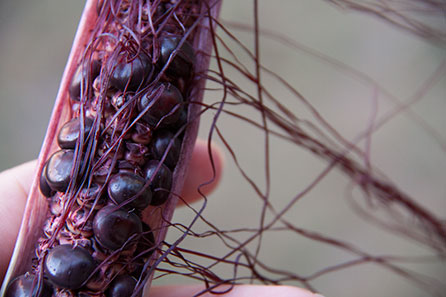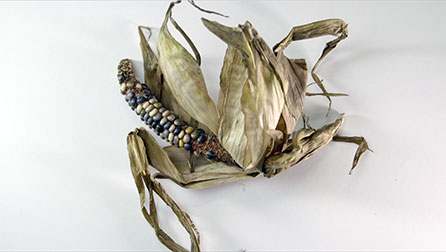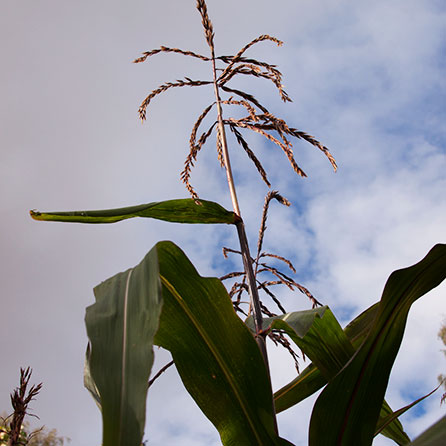| |
A Feeling for the Organism
This process oriented artistic research project (ongoing since 2018) is interrelated and partly overlaps with the project Anthropomorphic Interfaces, and has developed in conjuction with Storying Exposure (Pi: Cecilia Åsberg, KTH, and Hayden Lorimer, Glasgow University), a collaborative, interdisciplinary initiative and international gathering of Environmental Humanities researchers.
A Feeling for the Organism takes a small community garden in the city of Stockholm and a handful of maize seed as its point of departure. The seeds were a gift, but it turned out that this specific kind of maize was no ordinary corn. It is genetically very rich and diverse, and has been developed from over 70 different native American corn varieties from North America. Many of the heirloom cultivars it originates from are now extinct. Through interlacing the genetic research of Barbara McClintock (who coined the phrase "a feeling for the organism"), with the parallel inquiries into the ancient art of growing maize cultivated by Indigenous people in the Americas, and the history of the allotment movement in Europe, which gave poor urban workers access to land to grow their own food, A Feeling for the Organism attends to radically changing human-soil relations and the impact of monocultural thinking, in an attempt to creatively unlearn ingrained cultural patterns and regain a feeling for complex relational tangles and nonhuman organisms that are vital for human survival. |
|
|
| |
| |
| |
|
 |
|
|
|
|
| |
Around 6 700 years ago, somewhere in the area of present-day Peru, people sat around a fire, told stories, and shared a basket of popcorn. Archaeological discoveries tell us that popcorn is not a new invention. This fluffy nutritious cloud is the result of a very long human-plant collaboration, which resulted in a fantastic genetic diversity and resilience. Maize and people have travelled and lived together, developed together, and depended on each other for more than 9 000 years. The last hundred years though, agrobiodiversity has radically declined and with it locally varied food production systems, and local knowledges. Today, maize, or corn, is the world's most cultivated and genetically modified grain. It's one of twelve crops that dominate the global agricultural industry. Twelve crops alone, and five animal species, now make up 75% of the total global food production. This means that a massive part of our food production rests on a very vulnerable genetic base. Maize also happens to be a model organism in genetic research; so-called Indian corn was a life-long companion in the work of the pioneering geneticist Barbara McClintock, who coined the phrase "a feeling for the organism". Maize was first brought to Europe by Spanish colonizers, and then spread to Asia and Africa. What the colonizers didn't bring though, was the process of nixtamalización (involved in the making of masa and traditional Mexican tortilla) which allows for more nutrients to be absorbed by the human body. The colonizers brought the crop, but not the culture. |
| |
 |
| |
 |
| |
| The project has morphed and developed over time and been presented in different contexts and settings in the form of storytelling events, soundwalks, talks, seed sharing, the installation I Call Them Barbara, and as a monument, see * M * A * I * Z * E * A
Disseminated and Relational Monument. It has been presented in the talk "Flock Frequency Colony" at the first congregation of the Interplanetary Species Society Assembly by Jonas Staal, organized in collaboration with Statens Konstråd/Public Art Agency Sweden (24 Aug, 2019) as part of Choreographies of the Social curated by Edi Muka. With contributions by James Bridle, Kristine Dannenberg, iLiana Fokianaki, Vincent W.J. van Gerven Oei, Janna Holmstedt, Klaas Kuitenbrouwer, Charl Landvreugd, Aurélie Nyirabikali Lierman, Sven Lütticken, Felicity Scott and Anton Vidokle. A second presentation was made as a listening session and walk, "Shared Surfaces", in Walking Festival of Sound, Stockholm Edition. Curators, Tim Shaw and Jacek Smolicki, 5-8 Sep, 2019. A peer-reviewed article, " Interspecies Bodies and Watery Sonospheres: Listening in the Lab, the Archives, and the Field", will be published in Leonardo Music Journal Vol. 30 on Sound as Evidence of Geopolitical Events, ed. Morten Søndergaard (December2020). The essay "Follow the Blind, Mimic the Wind and Become a Worm" has been accepted for publication in Unlikely Journal for Creative Arts (November 2020). A fifth presentation will be made, as the panel "Welcome to the Backyard! Multispecies Figurations, Field-Philosophy, and Lateral Branching through Durational and Transformative Practices", has been accepted in STREAMS International Environmental Humanities Conference, hosted by KTH Environmental Humanities Laboratory, Stockholm, Sweden, 3–7 August 2021. The artists Janna Holmstedt, Thomas Laurien and Carol Padberg will present their own projects and engage in discussion with field philosopher Michelle Bastian.
<<
Back to research |
|
|
|
|